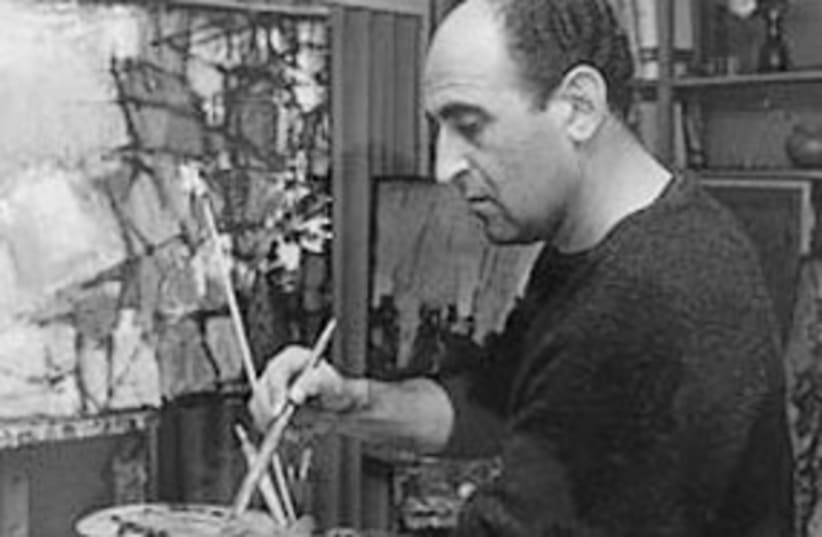Ukrainian-born Yitzhak Pugacz could not have hadany idea what life would hold for him when he left his parents and twohalf-sisters for British-controlled Palestine in 1939. The normallyone-week trek stretched into six as the rickety clandestine immigrantboat on which he traveled barely made it to its destination.
FIRST DAYS
Glad that he had made Palestine his new home, but desperate tosee his family, he enlisted in Britain's Jewish Brigade. He would fightthe Nazis in France and Italy and see the relatives he left behind. Thefirst part of his plan came to fruition, but he never saw his relativesagain.
When World War II ended and Pugacz finished hismilitary stint, he was entitled to a university education courtesy ofthe British government. He liked to paint and draw and developed anappreciation for the master European artists during his service, so hepursued a degree in art. Armed with a college education, he came backto Palestine only to fight again, this time in the War of Independence.But finally in 1948 he could embark on his career. He started and endedhis career at the prestigious Bezalel Academy of Design, ultimatelyrising to director of its painting department. Hundreds of Israelis owetheir careers to the man who built the fledgling department into thenational heavyweight it is today.
The spirit of immigration infused much of Pugacz's work including the painting HOPE, whichhe ultimately transformed onto the face of a coin commemorating the50th anniversary of Keren Hayesod. Although faceless, the men and womenholding hands in this painting exude the fierce determination theartist and his generation needed to build a modern country. In 1962 hewas awarded the Jerusalem Prize and in 1964 he went to Paris at theinvitation of the French government.
Hisability to capture the beauty, stillness and mystery of Jerusalem madehim a natural choice for an artisan to create coins celebrating specialoccasions. His metalwork included a unique coin designed for use at a pidyon haben (ceremony marking the redemption of a firstborn son).
Pugacz displayed the rare gift of a man who could teach as wellas paint, and paint as well as teach. A journalist described the sceneof the instructor Pugacz playing maestro to his Bezalel studentspainting empty wall space in Jerusalem to the psychedelic tunes of PinkFloyd during a 1970s all-nighter.
On a trip to Paris, he ran to buy paints and accidentallygrabbed the wrong bag as he left the crowded store. Although not hisusual choice of colors, he and his friend, poet Yehuda Amichai, had anidea. Pugacz would use the black and gold to create a series ofpaintings that served to illustrate a series of Amichai's poemscapturing the beauty of Jerusalem, and in 1970 a limited edition of Pictures and Songs was released.
CIRCLE OF FRIENDS
Thumbing through pictures in Pugacz's personal album is likelooking at a history book of Israel's early leaders. Pictures of himsitting at a table with Zalman Shazar share space with pictures of hisdaughters, Chana and Michal, as well as his late wife, Ruth.Discussions with Golda Meir and Jerusalem mayor Mordechai Ish-Shalomand education minister Zevulun Hammer were common for a man whocollaborated on a book with Amichai and counted journalist and TVpersonality Yaron London among his early students.
LANGUAGE
Though not his first language, Hebrew is clearly his language ofchoice. When being interviewed he made it clear that he wanted itconducted in Hebrew. After all, "Why speak in a foreign tongue?" washis first comment.
RELIGION
While he is an avowed secularist, Pugacz knows his Bible and canplace current events in historical context, easily referring toSimeon's and Levi's destruction of Shechem and battles throughoutJewish history.
BEST THING ABOUT ISRAEL
Pugacz always wanted to come to Palestine and build a country.His dream came true, and now he can see his great-grandchildren reapingthe fruits of his labor.
WORST THING ABOUT ISRAEL
Wearing shorts and sandals in his fourth-floor walk upapartment, Pugacz typifies the old-style Jerusalemite. He's a gentlecurmudgeon who still fiercely loves this country and believes thatJerusalem, in particular, is the best place to live. But he possesseslittle patience for a romanticized view of the country. He's aggravatedby the greed and fraud displayed by some of today's leaders and looksback longingly to a time when people were more concerned withcollective, as well as personal, survival.
CURRENT LIFE
Recently, Pugacz learned that a his 1956 painting Neveh Sha'anan, Emek Hamatzleva isnow hanging in Washington Hebrew Congregation, the only Americansynagogue founded by an act of Congress. Shortly thereafter, hisdaughters threw him a surprise 90th birthday bash attended by friends,students, grandchildren and great-grandchildren. Letters received fromstudents going back as many as 50 years show just how many lives hetouched and how his art captured the beauty of the country. A young boyfrom Ukraine has spent a lifetime capturing and sharing the beauty ofhis adopted homeland.
